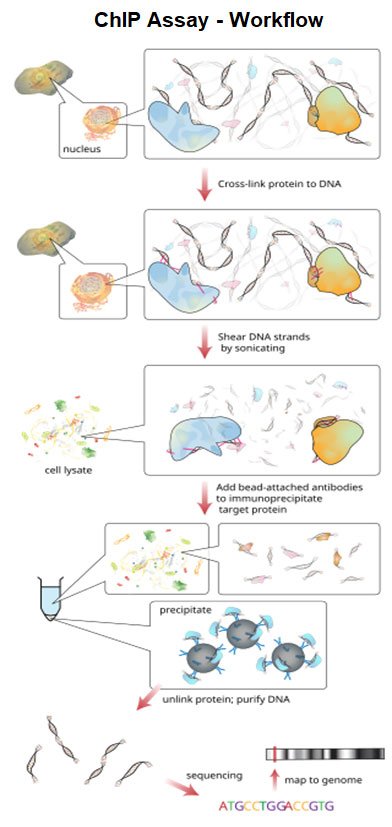Chromatin immunoprecipitation Assay or ChIP Assay is a technique to study the protein–DNA interactions within the cells. This technique is essential for identifying whether particular proteins (such as transcription factors) are bound to specific regions (such as promoters) of the DNA in the genome. In this post we will discuss the concept of Chromatin Immunoprecipitation Technique. You can Download the notes as PDF from the download link provided below the post.
What is Chromatin?
Ø Chromatin, composed of DNA and histone proteins, is the structure that organizes genetic material in the nucleus.
Ø This organization is essential for regulating the gene expression.
Ø DNA is packaged into nucleosomes and higher-order chromatin structures, which control the accessibility of transcriptional machinery.
Principles of Chromatin Immunoprecipitation
Ø Chromatin immunoprecipitation uses the specific interaction between an antibody and its target protein bound to DNA within the chromatin.
Ø Crosslinking proteins to DNA enable researchers to capture these interactions in their natural state.
Ø Immunoprecipitation then isolates the DNA-protein complexes, allowing identification of the associated DNA sequences.
Ø The effectiveness of this process depends on the antibody’s specificity and the chromatin’s integrity
Ø ChIP is a valuable method for studying the transcriptional regulation and epigenetic modifications.
Methodology of ChIP Assay
Ø In living cells or tissues, DNA and associated proteins on chromatin are crosslinked.
Ø The DNA-protein complexes are then fragmented into approximately 500 bp segments through sonication or nuclease digestion.
Ø Using a protein-specific antibody, the cross-linked DNA fragments bound to the protein of interest are selectively immunoprecipitated from the cell lysate.
Ø The associated DNA fragments are then purified, and their sequences are determined.
Ø Specific DNA sequences indicates the regions of the genome that the protein of interest interacts.

Jkwchui, CC BY-SA 3.0, via Wikimedia Commons
Types of ChIP Technique
Ø There are mainly two types of ChIP techniques based on the starting of chromatin preparation.
(1). Cross-linked ChIP (XChIP): Uses reversibly cross-linked chromatin sheared by sonication.
(2) Native ChIP (NChIP): Uses native chromatin sheared by micrococcal nuclease digestion.
Cross-linked ChIP (XChIP)
Ø Cross-linked ChIP is primarily used for mapping the target of transcription factors in the DNA.
Ø XChIP begins with reversibly cross-linked chromatin as the starting material.
Ø Formaldehyde or UV light is employed as the cross-linking agent.
Ø The cross-linked chromatin is then sheared by sonication.
Ø Sonication generates chromatin fragments ranging from 300 to 1000 base pairs (bp) in length.
Ø Chromatin fragments of 400 to 500 bp are ideal for ChIP assays, as they span two to three nucleosomes.
You may like: Nucleosome Model of Chromatin Organization (Notes)
Ø Cell debris in the sheared lysate is cleared by sedimentation.
Ø Protein–DNA complexes are selectively immunoprecipitated using specific antibodies targeting the protein(s) of interest.
Ø The antibodies are often attached to agarose, sepharose, or magnetic beads for separation and purification.
Ø The immunoprecipitated complexes are then collected and washed to eliminate non-specifically bound chromatin.
Ø The protein–DNA cross-links are then reversed, and proteins are removed through digestion with Proteinase K enzyme.
Ø The DNA associated with the complex is then purified and identified using one of the following methods:
@. Polymerase Chain Reaction (PCR)
@. Microarrays (ChIP-on-chip)
@. Molecular cloning and sequencing
@. Direct high-throughput sequencing (ChIP-Seq)
Native ChIP (NChIP)
Ø Native ChIP is primarily used for mapping the DNA targets of histone modifiers.
Ø Native chromatin serves as the starting material for the NChIP process.
Ø Since histones wrap around DNA to form nucleosomes, they are naturally linked.
Ø The chromatin is then sheared by micrococcal nuclease digestion.
Ø This digestion cuts DNA at the linker regions, preserving nucleosomes and generating DNA fragments ranging from one nucleosome (200 bp) to five nucleosomes (1000 bp) in length.
Ø Subsequent steps are similar to those in XChIP, include clearing cell debris, immunoprecipitating the protein of interest, removing the protein from the immunoprecipitated complex, and purifying and analyzing the associated DNA.
Applications of Chromatin Immunoprecipitation in Research
Ø ChIP enabled us to understand the interactions of proteins with DNA.
Ø ChIP has played a crucial role in mapping histone modifications, which are vital regulators of chromatin structure and function.
Ø By pinpointing the genomic locations of specific histone marks, researchers can infer the regulatory states of various genomic regions.
Ø ChIP is also extensively used to investigate transcription factor binding sites, offering valuable insights into gene regulation mechanisms.
Ø Beyond fundamental research, ChIP has been applied to study epigenetic changes linked to diseases, especially in cancer and developmental disorders.
Ø In a modified version, this technique can also be used for studying the interactions of proteins with RNA.
Summary: Chromatin immunoprecipitation remains a cornerstone technique in the study of gene regulation and epigenetics. Its continued development and application will undoubtedly provide further insights into the molecular mechanisms that underlie biological processes and diseases.
FAQ
1. What is chromatin immunoprecipitation?
2. What are the applications of ChIP technique?
3. How ChIP technique can be used to study the interactions between DNA and proteins?
4. What the different types of ChIP techniques?
5. Differentiate XChIP and NChIP.
<<< Back to Molecular Biology Notes Page
I hope you found this article on Chromatin immunoprecipitation Assay is informative and beneficial. Your feedback and comments would be greatly appreciated. Whether you have suggestions, questions, or thoughts to share, I would be delighted to hear from you. Engaging with your comments helps me continue to produce high-quality content in Biology. Please feel free to leave a comment below. Thank you for your support.
Regards: Admin, EasyBiologyClass
Want to read offline? download full PDF: Chromatin immunoprecipitation Assay
| You may also like NOTES in... | ||
|---|---|---|
| BOTANY | BIOCHEMISTRY | MOL. BIOLOGY |
| ZOOLOGY | MICROBIOLOGY | BIOSTATISTICS |
| ECOLOGY | IMMUNOLOGY | BIOTECHNOLOGY |
| GENETICS | EMBRYOLOGY | PHYSIOLOGY |
| EVOLUTION | BIOPHYSICS | BIOINFORMATICS |
